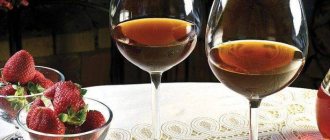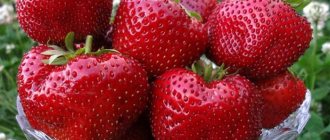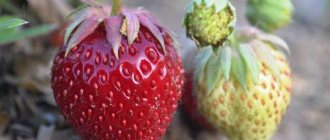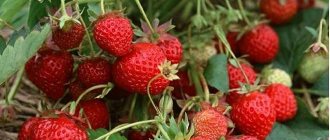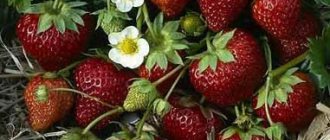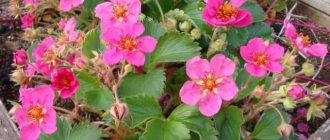Festival chamomile is a non-repairing variety of garden strawberry. The variety was developed in Ukraine in the late 1980s. The following strawberry varieties took part in the breeding work:
- Redcoat.
- Dawn.
In 1992, the variety was included in the State Register of Ukraine; the variety is not listed in the State Register of the Russian Federation.
In Russia, Festival chamomile is recommended to be grown in the following regions of the country:
- Central.
- East Siberian.
- West Siberian.
- Uralsk.
In this article you will learn a description of the variety, read reviews from gardeners about the Ukrainian beauty, and also see photos of its berries.
Description of the variety
The mid-early strawberry Romashka Festivalnaya is a one-time, non-repairing variety. It is distinguished by its friendly, short-term fruit ripening. The assortment was bred by Ukrainian breeders at the end of the last century, in 1992 it was officially included in the State Register, and is successfully cultivated in the West Siberian, Central, East Siberian, and Ural regions of Russia, in Ukraine - in the forest-steppe zone and in Polesie.
Bushes
The bushes of Chamomile Festival are medium-sized, semi-spreading, growing no more than 20 cm. The cap is densely leafy, dark green with a bluish bloom. There are not many whiskers, but they grow powerful and produce beautiful large rosettes. The bushes have from 10 to 15 thick flower stalks that grow to the level of the tops of the foliage.
The inflorescences contain more than fifty bisexual flowers. Powerful peduncles, under the mass of filling fruits, almost do not bend
Berries
The fruits in the first wave of fruiting are larger, their weight reaches 40 g, then they become smaller to 15-20 g. The berries have a regular round or blunt-conical shape and a characteristic neck. The appearance has a high commercial appeal. When ripe, the skin acquires a dark red or orange tint and shine. The pulp is red, dense, but juicy. The taste is harmonious, sweet and sour. Festival chamomile is very fragrant. During the fruiting period, a thick aroma of strawberries floats around the garden bed.
Tasters rate the taste of Festival chamomile at 4.9 points out of 5. In terms of product and consumer properties, the score is 8.3 points out of 9
Productivity
Festival chamomile begins to bear fruit in the second half of June and in just half a month the variety will yield its entire harvest. This quality is appreciated by summer residents who grow berries for sale, or want to get the harvest in large quantities for preparing preparations.
The yield of the variety varies greatly in different regions and with different cultivation techniques. Breeders have declared yields of up to 170-190 c/ha. On amateur plots, gardeners receive about 500 g of berries per bush. Strawberries of this variety can be harvested mechanically. The berries on thick peduncles do not lie down, the consistency is dense, and the fruits do not wrinkle. This feature of being kept high between the leaves allows the fruits to be well illuminated by the sun and ventilated. Therefore, when torn off, they are dry and clean, convenient for collection.
Festival chamomile strawberries were appreciated by housewives who know a lot about making sweet desserts, jam with whole berries, and compotes. Berries retain their shape and pulp density during heat treatment
Reviews from gardeners
Polina Grigorieva, Saratov region:
We inherited a dacha plot. This is where I spent my childhood. And the taste of “festival chamomile” has been familiar to me since those years. I have new interesting varieties, but I’m keeping my old favorite. Now my children eat it and praise it.
Alexey Chernenko, Volgograd:
A couple of years ago we bought a dacha with plantings. They removed a lot of things and planted their own. But they left the garden and strawberries. And they didn’t regret it. The previous owners said that the strawberry variety is “festival chamomile.” We liked it and we reproduced it. Now we eat ourselves, and our relatives get some. Tasty, large, and most importantly, unpretentious. For us, beginning gardeners, this is important.
a brief description of
Advantages of the variety
The Festival Chamomile variety competes with modern varieties due to its many advantages:
- excellent taste of fruits;
- pronounced aroma;
- possibility of transportation and long-term preservation of fresh fruits;
- withstands mechanized collection;
- does not bake in direct sunlight, can be grown in the southern regions;
- self-pollinating variety;
- can be grown in greenhouses;
- responds well to feeding, significantly increasing its productivity;
- high frost resistance;
- produces a moderate amount of whiskers;
- immunity to disease is higher than that of many modern varieties.
Disadvantages of the variety
- lack of moisture significantly reduces yield;
- large fruits only in the first wave of fruiting;
- without regular feeding, productivity decreases sharply.
The list of disadvantages is many times shorter and they are leveled out by good care.
Climate and growing regions
The variety is characterized by high winter hardiness and is frost-resistant down to -25 degrees and below. In temperate latitudes it winters well even without shelter for the winter. Also, Festival Chamomile bushes tolerate drought, temperature changes and other natural disasters well.
Thanks to this, strawberries of this variety can be grown almost throughout the entire territory of our country, even in Siberia and the Urals. If there are severe winters, when the temperature drops below -30, then the plants must be covered.
Landing
When planted in summer at the end of July, strawberries bear fruit the following year. Peak productivity can be expected from it in the next 2-3 years. Festival chamomile thrives in open sunny areas. The nearest tall buildings or trees should not be closer than 3 m, unless they are on the north side. But making a natural protective barrier from marigolds around the strawberry beds from drafts and insects is welcome. Swampy areas are not suitable for strawberries; groundwater should not come closer than 70 cm to the surface of the earth.
Loamy fertile areas with a neutral acidity level (optimally pH 5.5-6.0) are optimal for Chamomile.
The bushes are placed according to a single-line or two-line pattern, leaving 20-25 cm between compact plants and 50 cm between rows. It is convenient to care for plants planted using the nesting method. Creative gardeners use old car tires for such beds. It turns out not only beautiful, but also useful for the plant: the bed rises above the ground, drainage improves.
At least a month before planting, the area is cleared of weeds and debris and dug up with the simultaneous addition of humus (a bucket per m2), compost and wood ash (a glass per m2). The holes are moistened and the roots are straightened before planting. Pre-planting treatment of roots in a pink solution of manganese has a good effect for disease prevention. After planting, the plants are watered and the root zone is covered with hay, leaves, and rotted sawdust to retain moisture.
Strawberries grow well after legumes, carrots, onions, garlic, and corn. Do not plant after potatoes, cucumbers, any types of melons and raspberries
Strawberry “Festival Chamomile”: characteristics of the variety and features of agricultural technology
“Festival chamomile” is a strawberry variety that has been familiar to gardeners since the beginning of the 21st century. The variety has proven itself to be drought-resistant, winter-hardy, productive and unpretentious in care. It is often used for growing in open areas, but it can also grow in greenhouses.
Growing and care
When caring for Festival chamomile, standard agricultural techniques are used. It is imperative that you follow it, otherwise you will not achieve good productivity.
Watering
The plant will respond to an increase in humidity with diseases, and to a decrease - a deterioration in taste characteristics and a decrease in yield. The frequency of watering depends on the weather; usually in dry, hot weather, watering is carried out every 3-4 days. On cloudy days - once a week. For irrigation use settled warm water. Watering is carried out at the root, trying not to wet the leaves and peduncles. In late autumn, abundant moisture-recharging watering is carried out, which will prevent the plant roots from freezing.
Loosening, weed control
The root system of strawberries is located in the upper layers of the soil, so loosening is carried out to a depth of up to 5 cm. Simultaneously with loosening, weed germs are removed. Mulch allows you to reduce the labor intensity of work, because will reduce the number of waterings, eliminate loosening and weeds. You can use organic matter: straw, sawdust, pine, leaf litter or synthetic black non-woven materials: spunbond or agrospan.
Removing a mustache
To obtain good harvests, all whiskers should be trimmed before the horns develop on them. They are left only on bushes intended for breeding.
Top dressing
Strawberry Festival chamomile is responsive to regular feeding:
- Fertilizers are applied for the first time in early spring. This can be cow manure diluted 1:10, bird droppings (1:20) or a solution consisting of ammonium nitrate or urea (1 tablespoon per 10 liters of water). 0.5 liter is enough per bush. liquid fertilizer.
- The second feeding is carried out before flowering begins. A glass of ash is poured with boiling water, filtered, poured into a bucket and brought to a volume of 10 liters. Add 30 drops of iodine. Consumption per plant 0.5 l.
- In the summer, strawberries are fed several times with infusions of herbs - nettle, burdock, mint, wormwood, and garden weeds. The herbs are infused in a barrel for a week. This feeding will provide the plant with the elements necessary for full growth and fruiting.
If the soil is not very fertile, superphosphate is added in the fall. Nitrogen mixtures before wintering are undesirable, so as not to provoke growth.
Pest and disease control
The variety has a high degree of resistance to powdery mildew and many other diseases of berry crops. Festival chamomile is valuable because it is possible to grow environmentally friendly products without the use of chemicals.
If necessary, you can use folk remedies for prevention:
- plant garlic in the beds;
- Treat the bushes with a solution of mustard powder 2 times per season;
- Spray the leaves with a light pink solution of manganese 2-3 times a month.
You should not plant other varieties of berry crops that are prone to diseases next to Festival chamomile strawberries, so as not to provoke an epidemic.
Preparing for winter
Before wintering, carefully inspect the Festival chamomile plantation and remove damaged leaves and stems. The variety tolerates temperatures down to −25℃. In most regions it is able to overwinter without additional protection, under the snow.
Pests and diseases
As noted earlier, the variety has fairly strong immunity. However, if the crop is not properly cared for, it can still encounter a number of problems. The main problems that the Festival chamomile may encounter include:
- Spider mite. This parasite infects the leaves, sucking the juice from them. As a result of the pest's activity, the leaf blade becomes yellow and covered with a thin cobweb. The fruits ripen small and deformed. If the plantings are severely affected by this pest, then only pesticides will help. For minor lesions, they resort to folk remedies: garlic infusion, onion peel infusion, etc.
- Nematode. This is a small pest that affects the entire plant. If a pest has infected a bush, it must be quickly removed from the area so that the parasite does not infest healthy bushes.
- Powdery mildew. The main problem facing the Festival Daisy. With this disease, you can observe the appearance of a white coating on the leaf blades. To prevent this disease, you can treat the bushes with soda solution in early spring.
- Verticillium wilt. With this disease, dark spots can be seen on the surface of the leaf. If no measures are taken, the leaves will soon begin to die, the bush will become weak, lethargic and eventually die too. To prevent the plant from infecting healthy bushes, it must be removed from the site and burned.
Reproduction
Plantings are rejuvenated after 3-4 years of fruiting. It is advisable to propagate the variety by means of a mustache and dividing the bush.
To ensure that the rosettes on the tendrils take root well and are strong, the flower stalks on the mother plants are cut off. When dividing the bush, you need to make sure that each part has at least 2 leaves and a good root system.

